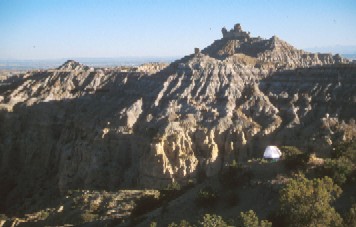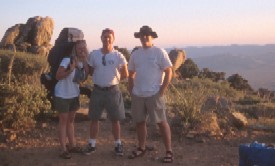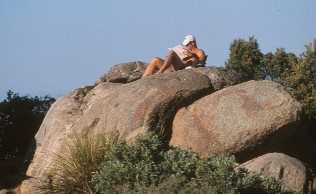THE
CAMPING EXPERIENCE
Surviving the Rugged Outdoors
in GGR 480,
The Capstone Undergraduate Field
Course.
This
web page includes:
-
Some
introductory photos and commentary.
-
What
to expect from the camping experience.
-
Checklist
of equipment to bring along.
-
Information
about equipment rental on campus.

Angel Peak Campground,
New Mexico. This site provided spectacular views and challenging
terrain on which to set up tents. One student found a "peninsula"
of land and literally camped "on the edge" (seen here). Each campsite,
weather fully developed or "primitive," provides its own unique geographical
setting and experience. The camping experience itself is an important
one for the field course, given that the class stays at each campsite for
a much longer period than any other designated stop along the trips.
Thus, the campsites present an opportunity to get to know a particular
place or environment for a little longer than just an hour or two.

Cerbats Range Campsite,
"above" Chloride, AZ. Three students pose impatiently for the
camera as they begin the task of setting up camp, the sun setting fast
in the distance. Although many campsites we visit maintain "full"
facilities, such as showers, occasionally there simply are not any developed
camp sites along the routes of our trips. Thus, a BLM "throw-down"
site such as this one provides for a unique camping experience! For
our "desert" trips, we try to camp as high as possible, as was the case
here. For more northerly "mountain" trips, camping low is a primary
goal.

"Morning Coffee and Paper".
Aside from an occasional "briefing" by the fearless professors, students
are typically allowed to recreate as they wish while at the campsites.
From experience, early mornings at camp are the most tranquil or peaceful
times of the field course. Usually by 8am, though, it's time to hit
the road again and pack up those vans!
See Field
Course Memoirs 2001, Page 4, for more detailed
accounts of the camping experience in 2001, from the perspective of Prof.
Tom Paradis.
WHAT CAN I EXPECT? WHAT ARE THE
CAMPSITES LIKE? WHAT ARE THE EXPECTATIONS? HOW WILL I SURVIVE
WITHOUT MY "MTV" (or nearby cell towers)?
The campsites:
After the class has arrived at a campsite for the night, students are generally
free to use time as they wish. Instruction stops here for the day,
and it is time to relax and enjoy the surroundings. In most cases,
the campsites we choose are within state parks or some other "semi-developed"
area. Occasionally we may ask students to chip in a few dollars to
pay for the site. Often, however, the sites are reserved in advance
and paid for by the Department of Geography and Public Planning.
Typically, campsites include group sites for tent camping and full shower/restroom
facilities. Sometimes it's a 5 minute walk from the campsite to the
facilities, but the fact that showers exist at all is usually a great plus.
The showers are usually free of charge, but sometimes they might require
25 or 50 cents. Because state parks and their respective campsites
are often located near lakes (usually artificially dammed), swimming opportunities
are more common than one might think. Occasionally, we will have
to camp at a "throw-down" site, where we literally "throw down" our tents
and equipment on bare public land (often in a designated camping area).
In such places there are no showers or restrooms -- perhaps a primitive
latrine. On multi-night camping trips, however, we try not to include
two consecutive throw-down sites in a row. It is wise to plan ahead
for camping without facilities, however, which usually involves little
more than packing some washcloths and soap, and a canteen of water to wash
up with.
Also
to keep in mind: It is the rare campsite that allows campers to build wood-burning
fires. Most places do not allow campers to collect wood at all.
Do not plan, therefore, to cook on a wood fire.
Typical Weather/Temperature
Conditions:
For those of you who are used to camping in sub-freezing alpine conditions,
you will most likely describe the GGR 480 camping experience as "wimpy".
But "wimpy" is good in this case. Being in the Southwest, precipitation
in May is highly unlikely, because May and June tend to be the "dry season".
Winter storms have moved northward with the Jet Stream, and the summer
monsoon pattern hasn't yet developed. In my five years of teaching
this course (through 2002), the class has been rained on only once at a
campsite. Further, minimum temperatures rarely fall below 60 degrees
because we are often camping in low-lying, semi-desert locations.
In Colorado for 2002, however, it is wise to expect that low temperatures
will likely be in the 40s. Overall, however, May is the perfect month
for this type of field course -- not too hot, not too cold, and often perfect
for camping! The wind is rarely an issue as well. Still, it is wise
to be prepared for the worst, and hope for the best. Come prepared
with some kind of water-resistent clothing and/or camping gear, and layered
clothing for chilly nights. In high elevations, including many places
we tend to visit, temperatures fall quickly after the sun goes below the
horizon.
Food and Meals:
We leave the "food issue" up to the preferences of the students.
Some students like to form "cooking groups," with one student bringing
a small propane stove, for instance. Others like to cook individually,
and many (such as myself) prefer not to cook at all. In any case,
our typical habit is to stop at a nearby grocery store before heading to
the campsite for the evening. Students can thus purchase what they
wish. Usually, this grocery stop happens between 5 and 6pm, so that
students can bring prepared food to the site. Or, there are usually
options for eating at or near the grocery stop so that food at the campsite
is not an issue at all. Still, it is always wise to pack a few non-perishable
snacks for those times when the hunger pangs begin, and when we are nowhere
near a store. Also, small coolers are very common, since students
can purchase bags of ice (often shared among several students) to keep
food and drink cool for the evening. We tend to make at least two
"ice stops" a day, to fill up the coolers.
Student Expectations:
In short, students are responsible for planning, organizing, and implementing
their entire camping experience (just as the instructors are responsible
for their own situations). Students should be fully prepared with
the proper equipment for specific trips, taking into consideration the
duration of the trip, the types of campsites, and the expected weather
circumstances. The old Boy Scout motto, "Be Prepared," is fully applicable
here! Students should not depend on others for their sustenance or
equipment, unless planned for in advance. Students are expected to
travel as light as possible, because space in the vans is limited for extensive
amounts of gear. After 2002, space will likely become even more precious
as NAU is planning to eliminate the roof racks from all the vans.
Roof rack or not, however, students will be responsible for packing and
unpacking the gear from the vans and making sure that it is secure on the
roof rack, if there is one.
Finally,
while evenings tend to be somewhat relaxing and without time pressures,
it is wise for students to be as efficient as possible in the morning while
"striking camp". We usually leave camp around 8am, and the vans need
to be packed up with all students ready to depart on time.
Departure times will be provided to the students in advance. Trust
me, you do NOT want to be the last student scurrying around to pack up
your stuff while everyone is waiting for you! Peer pressure in this
course tends to be severe :-).
A CAMPING CHECK-LIST
FOR GGR 480
- by Dr. Lee Dexter
(Some of these items are
considered optional. Use your own judgement.)
Clothing and toiletries:
Use layers and bring a couple
of sets:
-
Underwear
-
Light, long-sleeve cotton top
-
Sweater/sweatshirt
-
Wind/water repellent shell
-
Comfortable, wrinkle-free socks
-
Sturdy walking/hiking shoes
and/or sneakers
-
A hat that provides complete
sun protection
-
Clothing that you do not mind
getting dirty or stained.
-
anti-perspirant/deodorant (day
and night!)
-
toothbrush/toothpaste
-
Some TP, just in case.
-
wet-wipes (baby wipes) to wash
hands without water.
Food:
-
Stove (LP or white gas) (optional,
only if you plan to cook)
-
small ice chest: room for cool
drinks, snacks, some ice.
-
Water (1 gallon per person per
day is optimal)
-
A few simple cooking/eating
utensils
-
Clean-up supplies: soap, scrub
pad, etc.
-
non-perishable snacks, available
at any time.
-
Money, for food stops during
the day.
Camping gear:
-
small tent, easy to set up on
your own.
-
sleeping bag
-
foam pad or air mattress (non-electric!)
-
ground sheet or tarp for under
the tent.
-
flashlight
Small Day-pack:
-
hat
-
sunglasses
-
sunscreen (30 block or higher)
-
water bottle
-
wind/rain jacket
-
snacks/high-energy food
-
some cash/change, just in case
-
compass
-
small first aid kit
-
napkins and/or paper towels
-
camera
-
wet-wipes (baby wipes) to wash
hands without water
CHECK OUT THE NAU
OUTDOOR RECREATION WEB SITE FOR LIST OF CAMPING RENTAL SUPPLIES
AND PRICES. YOU CAN RENT CAMPING GEAR STRAIGHT FROM THE REC CENTER,
ON CAMPUS.


